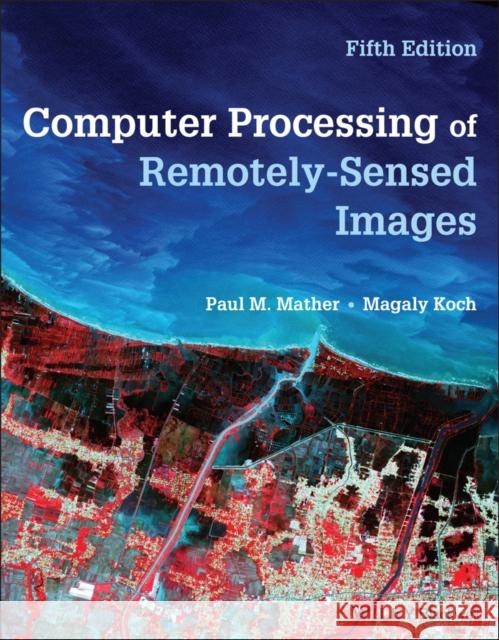Computer Processing of Remotely-Sensed Images » książka



Computer Processing of Remotely-Sensed Images
ISBN-13: 9781119502821 / Angielski / Miękka / 2022 / 384 str.
Computer Processing of Remotely-Sensed Images
ISBN-13: 9781119502821 / Angielski / Miękka / 2022 / 384 str.
(netto: 412,01 VAT: 5%)
Najniższa cena z 30 dni: 431,72
ok. 30 dni roboczych
Bez gwarancji dostawy przed świętami
Darmowa dostawa!
Preface to the First EditionPreface to the Second EditionPreface to the Third EditionPreface to the Fourth EditionPreface to the Fifth EditionList of ExamplesChapter 1: Remote Sensing: Basic Principles1.1 Introduction1.2 Electromagnetic radiation and its properties1.2.1 Terminology1.2.2 Nature of electromagnetic radiation1.2.3 The electromagnetic spectrum1.2.4 Sources of electromagnetic radiation1.2.5 Interactions with the Earth's atmosphere1.3 Interaction with Earth surface materials1.3.1 Introduction1.3.2 Spectral reflectance of Earth surface materials1.3.2.1 Vegetation1.3.2.2 Geology1.3.2.3 Water bodies1.3.2.4 Soils1.4 SummaryReferencesChapter 2: Remote Sensing Platforms and Sensors2.1 Introduction2.2 Characteristics of imaging remote sensing instruments2.2.1 Spatial resolution2.2.2 Spectral resolution2.2.3 Radiometric resolution2.3 Optical, near-infrared and thermal imaging sensors2.3.1 Along-Track Scanning Radiometer (ATSR)2.3.2 Advanced Very High Resolution Radiometer (AVHRR) and Visible Infrared Imager Radiometer Suite (VIIRS)2.3.3 MODIS (MODerate Resolution Imaging Spectrometer)2.3.4 Ocean observing instruments2.3.5 IRS LISS2.3.6 Landsat instruments2.3.6.1 Landsat Multi-Spectral Scanner (MSS)2.3.6.2 Landsat Thematic Mapper (TM)2.3.6.3 Enhanced Thematic Mapper Plus (ETM+)2.3.6.4 Landsat 82.3.6.5 Landsat 92.3.6.6 Landsat Next2.3.7 SPOT sensors2.3.7.1 SPOT High Resolution Visible (HRV)2.3.7.2 Vegetation (VGT)2.3.7.3 SPOT Follow-on Programme2.3.8 Advanced Spaceborne Thermal Emission and Reflection Radiometer (ASTER)2.3.9ESA Sentinel Programme2.3.9.1 Sentinel-2 Multi-Spectral Imager (MSI)2.3.9.2 Sentinel-3 OLCI and SLSTR2.3.10 High-resolution commercial and small satellite systems2.4 Microwave imaging sensors2.4.1. European Space Agency Synthetic Aperture Spaceborne Radars2.4.2 Radarsat2.4.3 TerraSAR-X and COSMO-SkyMed2.4.3 ALOS PALSAR2.4.4 Sentinel-1 SAR2.5 SummaryReferencesChapter 3: Pre-Processing of Remotely Sensed Data3.1 Introduction3.2 Cosmetic operations3.2.1 Missing scan lines3.2.2 De-striping methods3.2.2.1 Linear method3.2.2.2 Histogram matching3.2.2.3 Other de-striping methods3.3 Geometric correction and registration3.3.1 Orbital geometry model3.3.2 Transformation based on ground control points3.3.3 Resampling procedures3.3.4 Image registration3.3.5 Other geometric correction methods3.4 Atmospheric correction3.4.1 Background3.4.2 Image-based methods3.4.3 Radiative transfer models3.4.4 Empirical line method3.5 Illumination and view angle effects3.6 Sensor calibration3.7 Terrain effects3.8 SummaryReferencesChapter 4: Image Enhancement Techniques4.1 Introduction4.2 Human visual system4.3 Contrast enhancement4.3.1 Linear contrast stretch4.3.2 Histogram equalisation4.3.3 Gaussian stretch4.4 Pseudocolour enhancement4.4.1 Density slicing4.4.2 Pseudocolour transform4.5 SummaryReferencesChapter 5: Image Transforms5.1 Introduction5.2 Arithmetic operations5.2.1 Image addition5.2.2 Image subtraction5.2.3 Image multiplication5.2.4 Image division and vegetation indices5.3 Empirically based image transforms5.3.1 Perpendicular Vegetation Index5.3.2 Tasselled Cap (Kauth-Thomas) transformation5.4 Principal Components Analysis5.4.1 Standard Principal Components Analysis5.4.2 Noise-adjusted Principal Components Analysis5.4.3 Decorrelation stretch5.5 Hue, Saturation and Intensity (HSI) transform5.6 The Discrete Fourier Transform5.6.1 Introduction5.6.2 Two-dimensional Fourier transform5.6.3 Applications of the Fourier transform5.7 The Discrete Wavelet Transform5.7.1 Introduction5.7.2 The one-dimensional Discrete Wavelet Transform5.7.3 The two-dimensional Discrete Wavelet Transform5.8 Change Detection5.8.1 Introduction5.8.2 NDVI Difference Image5.8.3 Principal Components Analysis5.8.4 Canonical Correlation Change Analysis5.8.5 Time Series Analysis5.8.6 Summary5.9 Image fusion5.9.1 Introduction5.9.2 Hue, Saturation and Intensity (HSI) algorithm.5.9.3 Principal Components Analysis5.9.4 Gram-Schmidt orthogonalisation5.9.5 Wavelet based methods5.9.6 Evaluation - Subjective methods5.9.7 Evaluation - Objective methods5.10 SummaryReferencesChapter 6: Filtering Techniques6.1 Introduction6.2 Spatial domain low-pass (smoothing) filters6.2.1 Moving average filter6.2.2 Median filter6.2.3 Adaptive filters6.3 Spatial domain high-pass (sharpening) filters6.3.1 Image subtraction method6.3.2 Derivative-based methods6.4 Spatial domain edge detectors6.5 Frequency domain filters6.6 SummaryReferencesChapter 7: Classification7.1 Introduction7.2 Geometrical basis of classification7.3 Unsupervised classification7.3.1 The k-means algorithm7.3.2 ISODATA7.3.3 A modified k-means algorithm7.4 Supervised classification7.4.1 Training samples7.4.2 Statistical classifiers7.4.2.1 Parallelepiped classifier7.4.2.2 Centroid (k-means) classifier7.4.2.3 Maximum likelihood method7.4.3 Neural classifiers7.5 Sub-pixel classification techniques7.5.1 The linear mixture model7.5.2 Spectral Angle Mapping7.5.3 Independent Components Analysis7.5.4 Fuzzy classifiers7.6 More advanced approaches to image classification7.6.1 Support Vector Machines7.6.2 Decision tree classifiers7.6.3 Other approaches to classification7.6.3.1Rule based methods and the Genetic Algorithm7.6.3.2Object-oriented methods7.6.3.3Other methods7.6.3.3.1Evidential Reasoning7.6.3.3.2Bagging, boosting and ensembles of classifiers7.7 Incorporation of non-spectral features7.7.1 Texture7.7.2 Use of external data7.8 Contextual information7.9 Feature selection7.10 Classification accuracy7.11 SummaryReferencesChapter 8 Advanced Topics8.1 Introduction8.2 SAR interferometry8.2.1 Basic principles8.2.2 Interferometric processing8.2.3 Problems in SAR interferometry8.2.4 Applications of SAR interferometry8.3 Imaging spectroscopy8.3.1 Introduction8.3.2 Processing imaging spectrometer data8.3.2.1 Derivative analysis8.3.2.2 Smoothing and denoising the reflectance spectrum8.3.2.2.1 Savitzky-Golay polynomial smoothing8.3.2.2.2 Denoising using the Discrete Wavelet Transform8.3.2.3 Determination of 'red edge' characteristics of vegetation8.3.2.4 Continuum removal8.4 Lidar8.4.1 Introduction8.4.2 Lidar details8.4.3 Lidar applications8.5 SummaryReferencesAppendix AIndex
Paul M. Mather, PhD, now deceased, was Professor Emeritus at the University of Nottingham, UK.Magaly Koch, PhD, is a Professor at Boston University, USA.
1997-2025 DolnySlask.com Agencja Internetowa
KrainaKsiazek.PL - Księgarnia Internetowa









